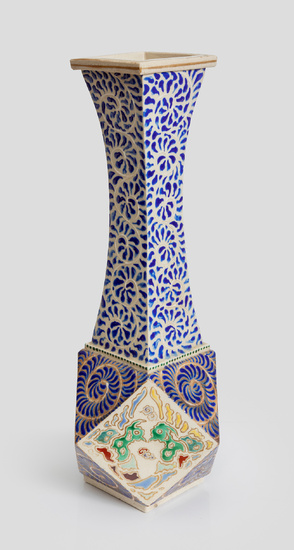Satsuma vase. Japan, XIX century.
Satsuma vase. Japan, XIX century.
Glazed ceramic.
Measurements: 36 cm. height.
Satsuma ceramic vase, endowed with an original design that forms a polyhedral figure in its belly, attached to a long neck of grooved facets. It also has a high quality polychrome glaze, following the decorative principles of Satsuma ceramics. The cobalt blue spirals and scrolls combine with figurative elements.
Satsuma ware has been made since the early 18th century on the island of Kyushu, and was a type of pottery with a strong Korean influence, as it was even brought to Korean potters. In the second half of the 18th century it became so popular in Japan that the production center was moved to Awata, near Kyoto. Thus, there is a local production in the eighteenth century, although the pieces for export in the nineteenth century, already produced in Awata, will have a greater importance. The paste is not porcelain, but a very light, porous light terracotta. The glaze is feldspathic, mixed with wood ash. The most characteristic feature of Satsuma pottery is its decorative richness, sometimes even exaggerated. Generally the motifs are brushed in gold glaze, as we see here, a novelty compared to previous styles. In addition, the ornamentation is completed with very varied polychrome enamels: green, red, white, turquoise, pink and, above all, "gosu" blue, the most sought after of all, with a very dark tone and typical of the best Satsuma of the 19th century. In addition, these are very thick glazes, which even have relief, as we see in these pieces. Regarding the decorative motifs, they were very varied, from the floral ones that dominate the domestic production to the figurative ones, the most common in the pieces destined for export.
HELP
View it on
Estimate
Time
Auction House
Satsuma vase. Japan, XIX century.
Glazed ceramic.
Measurements: 36 cm. height.
Satsuma ceramic vase, endowed with an original design that forms a polyhedral figure in its belly, attached to a long neck of grooved facets. It also has a high quality polychrome glaze, following the decorative principles of Satsuma ceramics. The cobalt blue spirals and scrolls combine with figurative elements.
Satsuma ware has been made since the early 18th century on the island of Kyushu, and was a type of pottery with a strong Korean influence, as it was even brought to Korean potters. In the second half of the 18th century it became so popular in Japan that the production center was moved to Awata, near Kyoto. Thus, there is a local production in the eighteenth century, although the pieces for export in the nineteenth century, already produced in Awata, will have a greater importance. The paste is not porcelain, but a very light, porous light terracotta. The glaze is feldspathic, mixed with wood ash. The most characteristic feature of Satsuma pottery is its decorative richness, sometimes even exaggerated. Generally the motifs are brushed in gold glaze, as we see here, a novelty compared to previous styles. In addition, the ornamentation is completed with very varied polychrome enamels: green, red, white, turquoise, pink and, above all, "gosu" blue, the most sought after of all, with a very dark tone and typical of the best Satsuma of the 19th century. In addition, these are very thick glazes, which even have relief, as we see in these pieces. Regarding the decorative motifs, they were very varied, from the floral ones that dominate the domestic production to the figurative ones, the most common in the pieces destined for export.
HELP



